|
|
|
Sort Order |
|
|
|
Items / Page
|
|
|
|
|
|
|
| Srl | Item |
| 1 |
ID:
134170
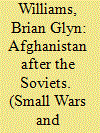

|
|
|
|
|
| Publication |
2014.
|
| Summary/Abstract |
In 1989 the Soviet Union withdrew its forces from Afghanistan leaving the embattled Afghan Communist government of President Mohammad Najibullah to fight against an emboldened mujahideen insurgency. Most experts expected a quick mujahideen victory once the Soviets were no longer directly involved in counterinsurgency operations in support of the Afghan government. But in the spring of 1989 the Afghan Communists beat the odds and defeated a mujahideen rebel offensive designed to capture the eastern city of Jalalabad. This proved to be a turning point, and for the next three years the Najibullah regime held out against the mujahideen 'freedom fighters'. In fact the Afghan Communist regime actually outlasted its sponsor the Soviet Union. The reasons for this remarkable achievement can be traced, in part, to ethnic-tribal divisions among the quarreling mujahideen parties and the Afghan government's ability to exploit them. This largely untold story has obvious implications for understanding the future of post-Karzai Afghanistan, tribalism, ethnicity, and foreign sponsorship in post-US Afghanistan. This article will explore the reasons for the resilience of the Najibullah Communist government and then assess possible implications for a post-2014 Afghan government.
|
|
|
|
|
|
|
|
|
|
|
|
|
|
|
|
| 2 |
ID:
099492
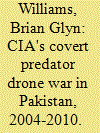

|
|
|
|
|
| Publication |
2010.
|
| Summary/Abstract |
This article provides the first overview of the CIA's secret drone campaign against Al Qaeda and the Taliban in Pakistan's tribal areas from its origins in 2001's Operation Enduring Freedom to the end of 2010. In the process it addresses the spatial dimensions of the campaign (where are the strikes being directed and where do the drones fly from), Pakistani reactions to this threat to both their sovereignty and an internal Taliban enemy, technological developments and Taliban and Al Qaeda responses to this unprecedented airborne assassination campaign. While the debate on this issue has often been driven by the extremes which either support the campaign as the most effective tool in killing terrorists or condemn it for driving Pakistanis to new levels of anti-Americanism, this article points out a third path. Namely, that many Pakistani Pashtun tribesmen living in the targeted areas support the strikes against the Taliban who have terrorized them in recent years.
|
|
|
|
|
|
|
|
|
|
|
|
|
|
|
|
| 3 |
ID:
101336
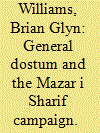

|
|
|
|
|
| Publication |
2010.
|
| Summary/Abstract |
This report sheds new light on the CIA and US Special Forces' covert campaign alongside Afghan Northern Alliance leader General Dostum's horse-mounted Uzbeks during 2001's Operation Enduring Freedom. In 2003 and 2005 the author traveled over the Hindu Kush Mountains to the plains of Northern Afghanistan and lived with the legendary Northern Alliance opposition leader General Dostum. His aim was to recreate Dostum's campaign alongside the CIA and Special Forces to seize the holy city of Mazar i Sharif from the Taliban in November 2001. Based on interviews with Dostum and his Uzbek commanders, this article recreates this proxy offensive that saw the Northern Alliance opposition break out of the mountains, seize this shrine town and bring the Taliban house of cards falling down in a matter of weeks. Up until now the indigenous Afghan Uzbeks, who played a crucial role as a 'boots on the ground' fighting force for Centcom, have been cast as a mere backdrop for American heroics. Now their side of the story and their links to the mysterious shrine of Mazar i Sharif are for the first time revealed.
|
|
|
|
|
|
|
|
|
|
|
|
|
|
|
|
| 4 |
ID:
159702
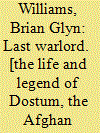

|
|
|
|
|
| Publication |
Noida, HarperCollins Publishers, 2013.
|
| Description |
xx, 334p.pbk
|
| Standard Number |
9789352644063
|
|
|
|
|
|
|
|
|
|
|
|
Copies: C:1/I:0,R:0,Q:0
Circulation
| Accession# | Call# | Current Location | Status | Policy | Location |
| 059415 | 958.104/WIL 059415 | Main | On Shelf | General | |
|
|
|
|
| 5 |
ID:
085541
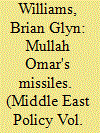

|
|
|
| 6 |
ID:
103424
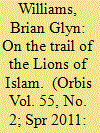

|
|
|
|
|
| Publication |
2011.
|
| Summary/Abstract |
This article provides a review of the history of jihadi foreign fighters in Afghanistan over the last 30 years. It details the post-9/11 period and the invasion of Afghanistan by U.S. forces, focusing on the ethnic origin of the foreign fighters and how different groups engaged in different aspects of the conflict. Additionally, the piece explains that while the foreign fighters who came to fight alongside the Taliban in Afghanistan included, among others, Uzbekistanis (not Afghan Uzbeks), Turks, and Arabs, there was also a significant force of Pakistanis-of both Pashtun and Punjabi origins-that joined, bolstering the Taliban army.
|
|
|
|
|
|
|
|
|
|
|
|
|
|
|
|
| 7 |
ID:
149118
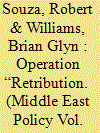

|
|
|
|
|
| Summary/Abstract |
September 30, 2016, marked the first anniversary of Russian President Vladimir Putin's decision to involve his nation militarily in the Syrian conflict on the side of Moscow's longtime ally, the Assad regime. According to initial Russian Defense Ministry statements and Putin himself, the mission had the primary objective of joining the U.S.-led coalition in fighting ISIS. Russia's chief of staff of the Presidential Executive Office at that time, Sergei Ivanov, using an alternative name for ISIS, laid out his country's official objectives on September 30, 2015: “The military goal of the operation is strictly to provide air support for the [Syrian] government forces in their fight against Islamic State.”1 The Mufti of Kazan (the head of Russia's Tatar community) and members of the Russian parliament lined up to support Putin's campaign in Syria, described as a “prophylactic against terrorist organizations” that was necessary to “destroy ISIS at its root.”
|
|
|
|
|
|
|
|
|
|
|
|
|
|
|
|
| 8 |
ID:
080776
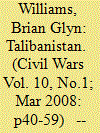

|
|
|
|
|
| Publication |
2008.
|
| Summary/Abstract |
This article traces the movement of foreign jihadis to the Pashtun tribal lands situated on the volatile Pakistani-Afghan border from the time of the CIA-sponsored Operation 'Cyclone' to the re-emergence of the Taliban in 2006-2007. The role of autonomous jihadi groups such as the Kashmiri parties, Uighurs, Chechens, Islamic Movement of Uzbekistan as well as the neo-Taliban insurgents and Al-Qaeda terrorist and 055 fighting forces are also analyzed. The article concludes with an overview of fighting and terror trends and future prospects along the Pakistani-Afghan border
|
|
|
|
|
|
|
|
|
|
|
|
|
|
|
|
| 9 |
ID:
105548
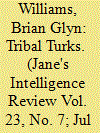

|
|
|
| 10 |
ID:
176600


|
|
|
|
|
| Summary/Abstract |
On March 20, 2019, President Donald Trump appeared on the White House lawn with two freshly declassified maps portraying the collapse of the ISIS caliphate. Trump did not expound on the origins of the maps, but the media suspected they came from the Pentagon, which regularly published such maps to display the progress of Operation Inherent Resolve. As the press corps shouted questions on the sudden reversal of his tumult‐inducing December 19 tweet order for “all” U.S. troops to be withdrawn from Syria in “30 days,” the president triumphantly pointed to the top map.
|
|
|
|
|
|
|
|
|
|
|
|
|
|
|
|
|
|
|
|
|